Priscilla
Lawson's portrayal of Princess Aura set a standard for adventuresome vixens which
stood unmatched for a couple of generations.
Aura was THE Spitfire of the Spaceways -- a transitional character between "Pre-Code"
Hollywood and "Hayes Office" Hollywood.
Besides her blazing sexuality, she was relatively complicated (for a figure in
an adolescent fantasy play).
Princess Aura could be good or bad, depending
on the circumstances. She was constantly driven to extremes of action by her lustful
infatuation for the "blond giant" Flash Gordon -- standing up against
the will of her formidable imperial father, and shooting ray guns while the men
were fighting each other with just their fists.
Priscilla
Lawson was one of the three lead actors in the credits, so she had a lot of screen
time in most episodes. Buster Crabbe's role was Action Hero. Jean Rogers' role
was Lady In Distress. Lawson's role wasn't so simple. Aura was an implacable nemesis
towards Dale, but she repeatedly saved Flash's life -- and also made trouble for
him and his friends again and again.
Dr. Zarkov, Prince Thun, and Prince Barin were all good. Emperor Ming and
his minions were all bad. Memorably barbaric King Vultan of the Hawkmen was the
only other character with good and bad dimensions besides Princess Aura.
Laying
down blow by blow accounts of Princess Aura's many Spitfire Scenarios would come
close to retelling the entire twelve-chapter Flash Gordon serial of 1936 -- she's
that important to whatever plot is unraveling, uh, unfolding at the time. I will
attempt some different ways of illustrating Aura's adventures and misadventures,
so I can make a few scholarly points and have fun as well. Long sequential chains
of events just won't suit our free-wheeling princess. I may paraphrase words,
or even reveal unspoken thoughts now and then.
I will start a series of Spitfire pages featuring Princess Aura I soon, but not
now -- the sample below demonstrates some of my points above: | 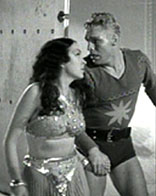
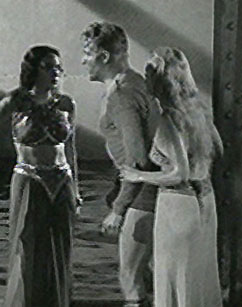 |
Princess
Aura DESPISES Dale Arden
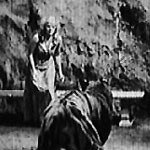
Who
sent a TIGER after me? | 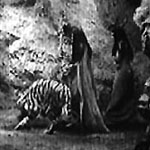
Darn cat -- find
the Earth Girl! | | Princess
Aura is CRAZY for Flash Gordon
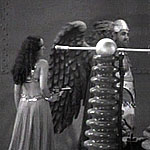
Set
Flash free, featherbrain. | 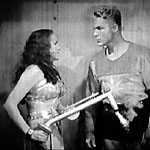
You're
dangerous, Aura! | |
So
what the %$#@! HAPPENED to Princess Aura in subsequent Flash Gordon serials?
Priscilla
Lawson signed a contract with MGM -- the most prestigious company in Hollywood,
so
she was not available for anymore Universal projects. Unfortunately,
she never played a major role at the new studio, and her prescence in the movies
declined.
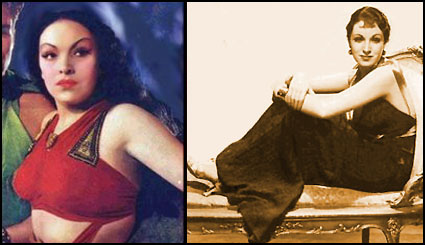
| Priscilla
Lawson at Universal | Priscilla
Lawson at MGM | |
The
Hayes Office became very powerful during 1936, and instituted a restrictive production
code which censored Hollywood movies until the 1960's. The first Flash Gordon
juvenile serial might have been the sexiest, but even those early costumes were
more conservative than the outfits drawn by Alex Raymond in the Hearst Newspapers
(which were read by the most conservative homes in the USA every
Sunday).
The skirts in the movies were longer, heavier, and nobody's navel showed. It was
the actors themselves who made their roles sexy or otherwise.
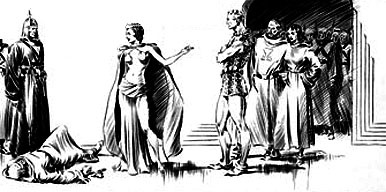
Flash Gordon & The
Witch Queen of Mongo by Alex Raymond 1935 | 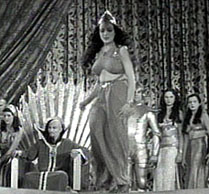
Ming's Palace in the movies
1936 |
The nature of women's roles in general were severely circumscibed by the Hayes
Office. Complicated female characters became more and more rare, even in A Grade
movies. Initiative was frowned upon for heroines, and villainesses were punished
without subtlety. B Grade novelties, like Buster Crabbe serials, took few chances
with the censors. Fleeting glimpses of harem dancers and attendants were as daring
as they got. All-bad villainess like Queen Azura and Lady Sonja died by the end
of each drama. Heroine Dale Arden was VERY passive in the first adventure, and
only went into action on a few occasions in the other two serials.
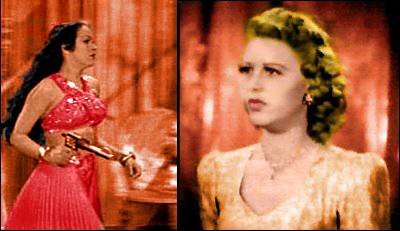
| Spitfire
Aura in 1936 | Bewildered
Aura in 1940 | |
By 1940, even Raymond had toned down the freewheeling barbarity of Flash Gordon.
Princess Aura was only drawn occasionaly, as Prince Barin's ultra-respectable
wife. Their Forest Kingdom mixed elements of a Zenda-like principality with Errol
Flynn's popular Robin Hood movie. Shirley Deane's wimpering shadow of Aura
was unfortunately true to the later newspaper version of her character. It may
also be worth noting that King Features Syndicate exercised more control over
Flash Gordon, Austin Briggs started a daily strip, and Alex Raymond would
quit in four more years. |